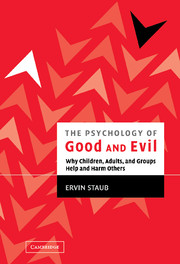Book contents
- Frontmatter
- Contents
- Preface
- Acknowledgments
- PART I INTRODUCTION AND CORE CONCEPTS
- PART II THE ROOTS OF HELPING OTHER PEOPLE IN NEED IN CONTRAST TO PASSIVITY
- PART III HOW CHILDREN BECOME CARING AND HELPFUL RATHER THAN HOSTILE AND AGGRESSIVE
- 10 The Origins of Caring, Helping, and Nonaggression: Parental Socialization, the Family System, and Cultural Influence
- 11 Natural Socialization: The Role of Experience or Learning by Doing
- 12 The Origins of Hostility and Aggression
- 13 Cultural–Societal Roots of Violence: Youth Violence
- 14 Bystanders and Bullying
- 15 Students' Experience of Bullying and Other Aspects of Their Lives in Middle School in Belchertown: Report Summary
- 16 Passive and Active Bystandership across Grades in Response to Students Bullying Other Students
- 17 Self-Esteem and Aggression
- 18 Father–Daughter Incest
- 19 Reducing Boys' Aggression: Learning to Fulfill Basic Needs Constructively
- 20 Creating Caring Schools: Design and Content of a Program to Develop Caring, Helping, Positive Self-Esteem, and Nonviolence
- PART IV THE ORIGINS OF GENOCIDE, MASS KILLING, AND OTHER COLLECTIVE VIOLENCE
- PART V THE AFTERMATH OF MASS VIOLENCE: TRAUMA, HEALING, PREVENTION, AND RECONCILIATION
- PART VI CREATING CARING, MORALLY INCLUSIVE, PEACEFUL SOCIETIES
- Appendix: What Are Your Values and Goals?
- Index
- References
20 - Creating Caring Schools: Design and Content of a Program to Develop Caring, Helping, Positive Self-Esteem, and Nonviolence
Published online by Cambridge University Press: 07 May 2010
- Frontmatter
- Contents
- Preface
- Acknowledgments
- PART I INTRODUCTION AND CORE CONCEPTS
- PART II THE ROOTS OF HELPING OTHER PEOPLE IN NEED IN CONTRAST TO PASSIVITY
- PART III HOW CHILDREN BECOME CARING AND HELPFUL RATHER THAN HOSTILE AND AGGRESSIVE
- 10 The Origins of Caring, Helping, and Nonaggression: Parental Socialization, the Family System, and Cultural Influence
- 11 Natural Socialization: The Role of Experience or Learning by Doing
- 12 The Origins of Hostility and Aggression
- 13 Cultural–Societal Roots of Violence: Youth Violence
- 14 Bystanders and Bullying
- 15 Students' Experience of Bullying and Other Aspects of Their Lives in Middle School in Belchertown: Report Summary
- 16 Passive and Active Bystandership across Grades in Response to Students Bullying Other Students
- 17 Self-Esteem and Aggression
- 18 Father–Daughter Incest
- 19 Reducing Boys' Aggression: Learning to Fulfill Basic Needs Constructively
- 20 Creating Caring Schools: Design and Content of a Program to Develop Caring, Helping, Positive Self-Esteem, and Nonviolence
- PART IV THE ORIGINS OF GENOCIDE, MASS KILLING, AND OTHER COLLECTIVE VIOLENCE
- PART V THE AFTERMATH OF MASS VIOLENCE: TRAUMA, HEALING, PREVENTION, AND RECONCILIATION
- PART VI CREATING CARING, MORALLY INCLUSIVE, PEACEFUL SOCIETIES
- Appendix: What Are Your Values and Goals?
- Index
- References
Summary
background and objectives
In this chapter I will describe a program to create schools in which students' experiences in their classrooms promote caring about the welfare of others and the inclination to help others. The influences that give rise to caring and helping are in many respects the opposite of those that develop hostility and aggression in children and youth (Staub, 1986, 1996a, in preparation), and an additional central aim of this program is to lessen hostility and aggressiveness. The latter is best accomplished, however, by creating conditions and experiences that promote caring, cooperation, and helpfulness. Part of the focus of this program is to develop caring about members of racial, religious, or ethnic groups other than one's own, what I will refer to as inclusive caring. The program also aims to foster positive self-esteem, since children and adolescents have to value themselves to a reasonable degree if they are to value and help others. Beyond caring about individuals, the program also promotes feelings of responsibility for the social good. As a by-product of the classroom milieu created and the students' experiences in the classroom, positive effects on learning are also expected.
The program consists of workshops with teachers and other school personnel, and follow-up training with them to translate the ideas, perspectives, and skills they had acquired in the workshops into classroom practice. It also includes workshops with parents, so that their ways of relating to and guiding children at home may become supportive of the school effort.
- Type
- Chapter
- Information
- The Psychology of Good and EvilWhy Children, Adults, and Groups Help and Harm Others, pp. 267 - 286Publisher: Cambridge University PressPrint publication year: 2003



